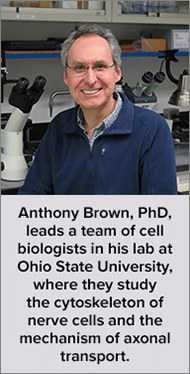CMTA collaborates with leading gene therapy scientists at OSU

The CMTA Board of Directors recently voted to fund a $265,000 research project for CMT2E. The study aims to advance CMT2E gene therapy by demonstrating positive results for axonal forms of CMT affecting motor neurons.
The project involves a new collaboration among the Ohio State University labs of Anthony Brown, PhD, Arthur Burghes, PhD, Kathrin Meyer, PhD, and W. David Arnold, MD. Several members of the team were involved in the development of gene therapy for spinal muscular atrophy from mouse models to patients.
The labs have complementary expertise in neurofilament biology, mouse genetics, gene therapy, viral vectors, neurodegenerative disease and electrophysiological assessments of neuromuscular function.
Scientific Advisory Board (SAB) reviewers noted the strength of this project proposal, noting that the collaboration of these scientists “greatly enhances the likelihood of success.” The investigators at Ohio State University labs have a history of productive collaboration and translation of preclinical studies to clinical trials.
CMT2E is caused by dominant mutations in the neurofilament protein L (NEFL) gene, but there are also some individuals with CMT who have recessive mutations in the same gene. According to the SAB review summary, the proposal addresses unresolved questions about the underlying mechanism for CMT2E, proposing as a unifying hypothesis that both recessive and dominant forms of disease result from lost function of NEFL.
The study’s goal is to evaluate gene therapy strategies for restoring neurofilaments to diseased neurons in Type 2 mice. If the approach is successful, the preclinical studies will set the stage for obtaining approval for clinical trials.





